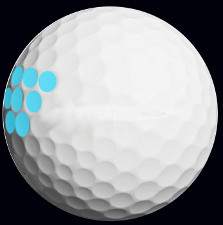
In golf, the term “ball dimples” refers to the small indentations or depressions on the surface of a golf ball. These dimples play a significant role in the ball's aerodynamics and affect its flight characteristics, distance, and trajectory.
The dimples on a golf ball create a turbulent boundary layer of air around the ball as it moves through the air. This layer helps to reduce drag and increase lift, allowing the ball to maintain a more stable and efficient flight.
The number, size, and pattern of dimples on a golf ball can vary depending on the manufacturer and model. Typically, a standard modern golf ball has between 300 and 500 dimples, although the exact number can vary. The dimples are arranged in a symmetrical pattern, with common shapes being circular, hexagonal, or a combination of both.
The primary functions of golf ball dimples are:
- Lift: The dimples on a golf ball create lift by affecting the airflow around the ball. As the ball moves through the air, the dimples help to decrease the pressure on top of the ball and increase the pressure on the bottom, generating lift. This lift force helps the ball stay in the air longer and maintain a more extended flight.
- Drag Reduction: The dimples also reduce the drag or air resistance on the golf ball. The turbulent boundary layer created by the dimples allows the air to flow more smoothly around the ball, reducing the drag and allowing the ball to travel farther. This reduced drag contributes to increased distance off the tee and improved overall performance.
The specific dimple pattern and design can impact the performance characteristics of a golf ball. Different dimple configurations can affect the trajectory, spin rates, and overall stability of the ball in flight. Golf ball manufacturers continually research and develop new dimple designs to optimize performance and maximize the ball's aerodynamic efficiency.
It's important to note that the rules of golf dictate specific standards for golf ball dimples, including the maximum depth and diameter of the dimples. These regulations ensure fairness and consistency in the game.
In summary, the dimples on a golf ball are essential for optimizing its aerodynamic performance. By creating lift and reducing drag, the dimples help golfers achieve greater distance, accuracy, and control in their shots.
The small, round indentations on a golf ball’s surface, dimples cause the ball to fly farther by creating lift. Different golf ball models are made with varying numbers and arrangements of dimples to generate different playing characteristics. The number and pattern of dimples may influence a ball’s trajectory and spin rate, for example.
Most golf balls have between 330-500 dimples.






